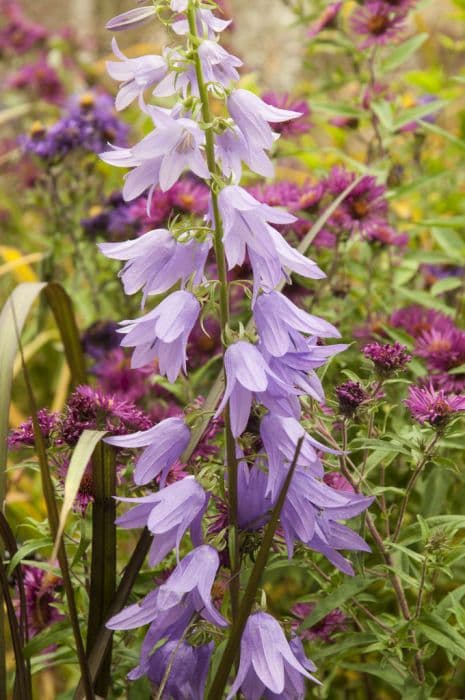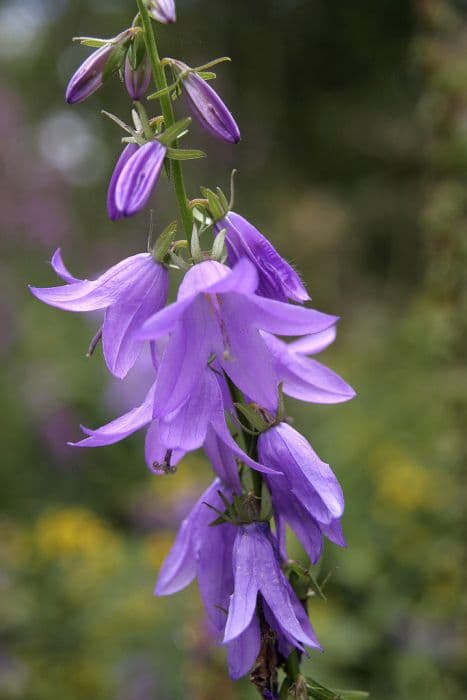Fairies Thimbles Campanula cochlearifolia

ABOUT
The plant known as fairy thimbles is a charming and dainty perennial that adds a touch of whimsy to any garden. This plant is characterized by its basal rosettes of small, rounded to heart-shaped leaves that are bright to dark green in color. In the blooming season, fairy thimbles produce an abundance of bell-shaped flowers that dangle gracefully on thin, wiry stems. These delightful flowers are usually a soft, pale blue to violet in tone, providing a gentle splash of color. The blooms are nodding, which lends a delicate look to the plant's overall aesthetic. The fairy thimbles' leaves and flowers combine to create a lush, cottage garden feel, inviting a variety of pollinators to come and visit. Notably, the flowering stems branch and spread, which adds to the plant's enchanting, fairy-like appearance.
About this plant
 Names
NamesFamily
Campanulaceae
Synonyms
Fairies’ Thimbles, Fairy’s Thimble, Tiny Bell, Earleaf Bellflower
Common names
Campanula bellidifolia, Campanula pumila, Campanula rotundifolia var. cochlearifolia, Campanula cochleariifolia.
 Toxicity
ToxicityTo humans
The plant known commonly as fairy thimble is generally considered non-toxic to humans and does not typically cause serious harm if ingested. However, like any plant material, it may cause some mild discomfort such as an upset stomach or skin irritation to sensitive individuals. It is advisable to avoid consuming any plant unless it is known to be safe for human consumption.
To pets
Fairy thimble is also considered non-toxic to pets. It is not known to cause serious harm if pets ingest plant parts. As with humans, mild gastrointestinal upset or irritation could occur, especially if a pet consumes large quantities of the plant. Always monitor your pets for any signs of distress after ingesting unknown plant materials and consult a veterinarian if you have any concerns.
 Characteristics
CharacteristicsLife cycle
Perennials
Foliage type
Deciduous
Color of leaves
Green
Flower color
Blue
Height
0.5 feet (15 cm)
Spread
1 feet (30 cm)
Plant type
Herb
Hardiness zones
3-7
Native area
Europe
Benefits
 General Benefits
General Benefits- Attracts pollinators: Campanula cochlearifolia, commonly known as fairy thimbles, is attractive to bees and butterflies which help with pollination.
- Low maintenance: Fairy thimbles are known for being easy to care for, requiring little attention once established in the garden.
- Drought tolerance: Once established, fairy thimbles can tolerate periods of dry weather, making them suitable for gardens in dryer climates.
- Ground cover: With its spreading habit, fairy thimbles can form dense mats, which helps to suppress weeds and cover bare spots in the garden.
- Aesthetic appeal: The delicate bell-shaped flowers and lush foliage provide ornamental value to garden beds, borders, and rock gardens.
- Erosion control: The plant's root system helps to stabilize soil, which can be beneficial on slopes or areas prone to erosion.
- Versatility: Fairy thimbles can be grown in containers, hanging baskets, or directly in the ground, offering flexibility in garden design.
 Medical Properties
Medical PropertiesThis plant is not used for medical purposes.
 Air-purifying Qualities
Air-purifying QualitiesThis plant is not specifically known for air purifying qualities.
 Other Uses
Other Uses- Fairy Gardens: Campanula cochlearifolia, commonly known as "Fairy's Thimble," is often used to create enchanting scenes in fairy gardens due to its delicate, bell-shaped flowers and small size.
- Alpine Rockeries: The plant can be a charming addition to alpine rockeries, where its compact form and ability to grow in rocky crevices adds texture and interest.
- Photography: Because of its picturesque appearance, Fairy's Thimble is a favorite subject for photographers seeking to capture the essence of a woodland or cottage garden.
- Crafts: Dried Fairy's Thimble flowers can be used in crafts, such as pressed flower art and for decorating wreaths or picture frames.
- Garden Borders: Its low-growing habit makes it ideal for edging borders, adding a touch of blue or white on the edges of pathways or beds.
- Ground Cover: When planted en masse, Fairy's Thimble serves as an attractive ground cover, providing a carpet of foliage and blooms.
- Education: This plant can be used as a teaching tool in botany and gardening classes to illustrate ground cover development and alpine plant adaptations.
- Artistic Inspiration: The dainty flowers and leaves of Fair's Thimble have inspired artists for botanical illustrations and garden-themed artwork.
- Floral Arrangements: Fairy's Thimble can be incorporated into miniature floral arrangements and petite bouquets for dollhouses and small table settings.
- Theme Gardens: Ideal for planting in whimsical or storybook-themed gardens, creating an atmosphere of magic and charm.
Interesting Facts
 Feng Shui
Feng ShuiThe plant Campanula is not used in Feng Shui practice.
 Zodiac Sign Compitability
Zodiac Sign CompitabilityThe plant Campanula is not used in astrology practice.
 Plant Symbolism
Plant Symbolism- Gratitude: Campanula cochlearifolia, commonly known as the fairy thimble, has a delicate and charming appearance, often symbolizing feelings of thankfulness or appreciating someone's kindness.
- Humility: The fairy thimble's unassuming presence in rock gardens and borders conveys a sense of modesty and the importance of simplicity.
- Constancy and Perseverance: As a perennial plant that returns each year, the fairy thimble represents enduring commitment and the will to persevere through challenges.
- Eternal Love: With its bell-shaped flowers that return annually, it is often associated with the idea of love that never fades.
 Water
WaterThe Fairy Bellflower (Campanula cochlearifolia) should be watered deeply to ensure the moisture reaches the roots, and the soil should be allowed to dry out slightly between waterings to avoid waterlogging. This plant prefers consistently moist soil, so providing it with about 1 gallon of water once a week during the growing season is ideal, adjusting for rainfall and temperatures. During hotter dry spells, you might need to water twice a week, while in cooler or rainy periods, watering might need to be less frequent. It's important to water the plant at its base to minimize wetting the foliage, reducing the risk of disease.
 Light
LightFairy Bellflower thrives best in partial shade, adapting to morning sun with afternoon shade or dappled sunlight throughout the day. It can also grow in full sun, but in areas with particularly hot summers, the intense afternoon sun may be too much, so a spot that offers some relief from heat is preferable. Avoid deep shade, as this can hinder the plant's flowering.
 Temperature
TemperatureFairy Bellflower fares well in a wide range of temperatures but performs best in cooler conditions. It can survive minimum temperatures down to about 14 degrees Fahrenheit, but it grows ideally in temperatures averaging between 50 and 70 degrees Fahrenheit. Extreme heat can stress the plant, so in regions with hot summers, providing some shade can help to maintain a cooler ambient temperature.
 Pruning
PruningPruning Fairy Bellflower is done to maintain its shape, encourage denser growth, and remove spent flowers to potentially stimulate a second bloom. Deadheading, or cutting off the faded flowers, regularly during the blooming season can help the plant direct its energy into producing more flowers. After the plant has finished flowering, cut back the foliage to the ground in fall to keep the plant tidy and healthy, and to promote vigorous growth in the spring.
 Cleaning
CleaningAs needed
 Soil
SoilFairy Bells prefer well-draining soil with a mixture of compost, perlite, and peat. An ideal pH range for Fairy Bells is between 6.0 and 7.5. Use a balanced potting mix and ensure proper drainage to prevent root rot.
 Repotting
RepottingFairy Bells typically need repotting every two to three years to refresh the soil and prevent the roots from becoming pot-bound. Best done in spring or early summer.
 Humidity & Misting
Humidity & MistingFairy Bells thrive in moderate to high humidity conditions; however, they are quite adaptable and can tolerate less humid environments typical of most homes.
 Suitable locations
Suitable locationsIndoor
Provide Fairy Bells with bright indirect light and regular watering.
Outdoor
Plant in partial shade; protect from strong winds and midday sun.
Hardiness zone
3-8 USDA
 Life cycle
Life cycleCampanula cochlearifolia, commonly known as the fairy's-thimble, begins its life cycle with seed germination, usually occurring when soil temperatures are appropriate and moisture is available. The germinated seeds develop into small vegetative rosettes, with leaves that are initially simple and basal. As the plants mature, they undergo vegetative growth, where the rosettes expand and the plants form clumps. Flowering typically occurs in the summer, when erect flowering stalks rise from the rosettes, bearing nodding, bell-shaped blue or purple flowers that attract pollinators for sexual reproduction. After pollination, the flowers produce capsules containing numerous small seeds, which are dispersed by wind or gravity. The plant often enters a period of dormancy during the colder months, only to begin a new growth cycle with the return of favorable conditions.
 Propogation
PropogationPropogation time
Spring-Early Summer
The most popular method for propagating fairy bells, also known as Campanula cochlearifolia, is by sowing seeds. To achieve optimal results, it is generally recommended to plant the seeds in the spring after the danger of frost has passed, or indoors about 8 to 10 weeks before the last expected spring frost. Seeds should be superficially sown on top of well-draining soil mix and lightly pressed in, as they require light for germination. Keeping the soil consistently moist but not waterlogged is important. Germination can vary, typically occurring within two to four weeks at 65 to 70°F (18 to 21°C). Once seedlings are large enough to handle, they can be transplanted outdoors to their final growing positions, spaced about 6 to 12 inches (15 to 30 centimeters) apart.









